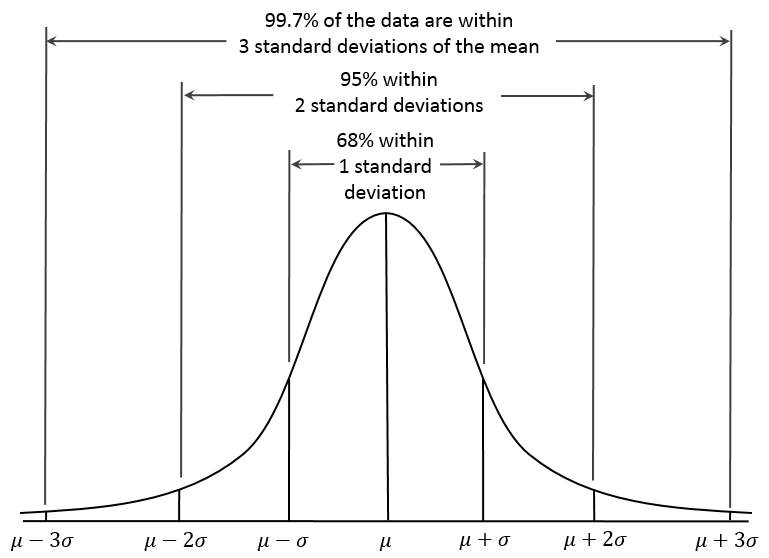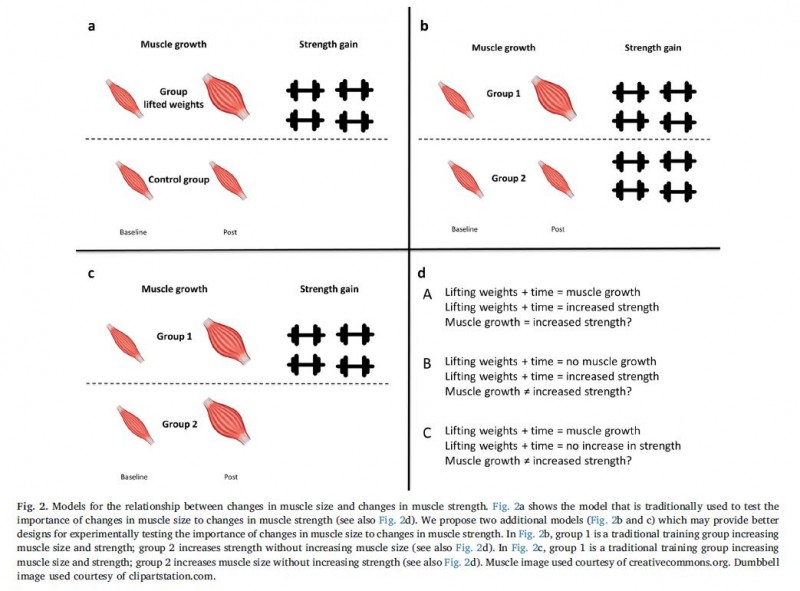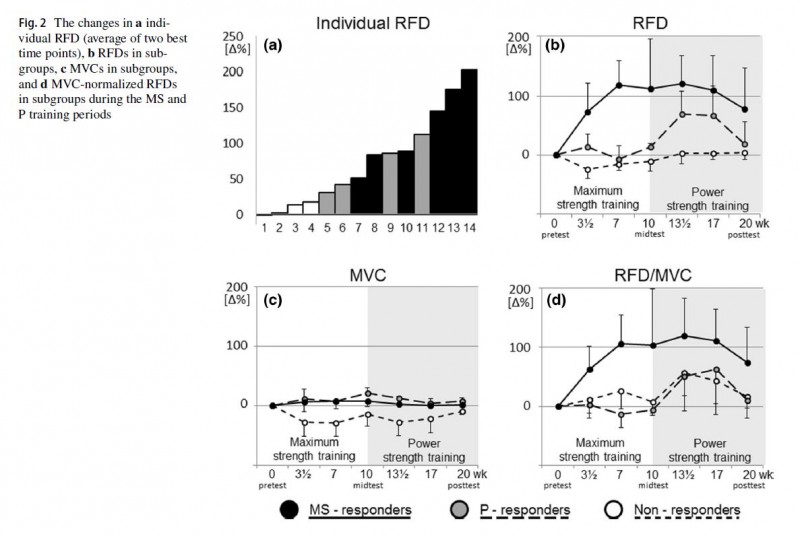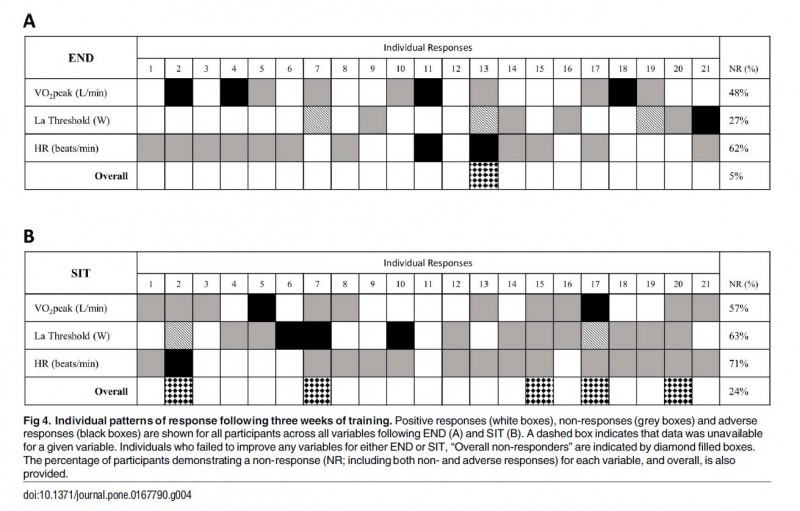
Introduction: Inter-individual Variation and Populational Diversity
Why are some athletes freaks of power? Why do some people recover fast and others don’t? Why do people respond so differently to drugs?
How much, in health and disease, in training and other aspects of life, is any rule applicable to all, to a subpopulation of humans or only one individual?
Why is something a sign of disease in some people and not in others?
I plan to explain what is and what we know about biological uniqueness, inter-individual variability and how, in spite of them, you can make training, health and life decisions without the assistance of a research team. I will begin by examining inter-individual differences in training response in this article. I hope to get you fascinated enough to follow the next articles on nutrition and finally on health and disease (or defining what is "pathological" to understand what is being ill and what is just being atypical, or diverse).
I suspect some folks may react in dismay to case after case supporting the argument for uniqueness over uniformity: “How can I make an informed decision if everything is so individual?” At the end of each article, I will discuss how to navigate our uniqueness, from identification to decision-making.
Freak Power: The Case of Amanda Nunes
The question that never ceases to be asked: What makes some people so much faster, powerful, stronger, resistant, agile or precise than others? So much so that their accomplishments are faced with disbelief, far outliers in the normal curve? The short answer is the proverbial interplay of nature and nurture. The long answer is much more complicated and full of knowledge gaps.
By Dan Kernler - Own work, CC BY-SA 4.0,
For the normal distribution, the values less than one standard deviation away from the mean account for 68.27% of the set; while two standard deviations from the mean account for 95.45%; and three standard deviations account for 99.73%.
MMA fighter Amanda Nunes was again named “fighter of the year” and is widely considered the best female fighter in the history of MMA. What is so special about Amanda?
When we look at her and her contenders, we will see some anthropometric variation but at the elite level, on a weight-class based sport, their bodies are not significantly different. One may have a muscular advantage, another a reach advantage but none of these variables explain Amanda’s dominance in the sport. Cristiane “Cyborg” Justino, for example, is more muscular than Amanda. Considering that muscular strength is proportional to the cross-sectional area of the primary motor muscles involved in muscular contraction strength (McGinnis 2013, pp. 287), Cyborg could be “stronger”. That’s not how it works, though. First, what strength is at stake here? The first experimental measurement of physical strength was the 1RM or maximum voluntary contraction (MVC) of any given motor task. However, static and dynamic strength are quite different animals (Zatsiorsky & Kraemer 2006, pp. 64). Maybe, just maybe, Amanda is not as strong as Cyborg for certain static motor tasks. What is at stake in a fight, however, are very different things. The predominant strength component is dynamic and, therefore, total power output, rate coding (the rate at which recruited motor units discharge action potentials) and rate of force development (rate in which the force is developed) will be the determinant factors. Rate of force development (RFD) has consistently been shown to be the most determinant physical capacity in explosive sports performance (Enoka & Duchateau 2017, Maffiuletti et al 2016, Hernández-Davó & Sabido 2014). Even the old assumption concerning the relationship between cross-sectional area and muscle strength is not consensual anymore and certainly much more complicated than what is taught to undergraduate students (Jones et al 2008).
Up to now, we’re just talking about strength, in its dynamic manifestation. We haven’t even considered kinesthetic awareness, which determines precision, proprioception, also an important component of precision and skill, agility and other motor-related neural processes that we barely understand (Proske 2006, Hutton 1966, Proske & Gandevia 2009, Tuthill & Azim 2018).
When commentators say “she hits hard”, what they mean is that her total power output and her rate of force development are off the chart.
What is Amanda’s freak power made of, then? Who knows? All of the things above plus an infinite number of emotional and cognitive variables that make her (and everybody else) unique. Her uniqueness, unlike yours or mine, makes her the best, ever, female fighter in the world.
But make no mistake: everybody is unique in many things, the great majority of which we don’t and will never know. The notorious unique individuals, in whatever expression of human excellence, happen to be unique in things that are socially valued, measurable and recognized.
Response to Training: Variation is Bigger Than Uniformity
We don’t want to explain the freaks, the total outliers, right? They give us a headache. Luckily, the majority of people will respond in a more predictable way to training stimuli. Ha! Think again. They don’t. Today we know that inter-individual variability in any training stimulus is the rule rather than the exception.
Studies about the inter-individual variability in the response to strength training have shown that not only it varies considerably between individuals but the amount of variation appears to differ depending on the measured variable (Erskine et al 2010). What the charts below show is the magnitude of the standard deviation from the average, or how far from the average each individual is regarding the measured variables. As you can see, "a lot".
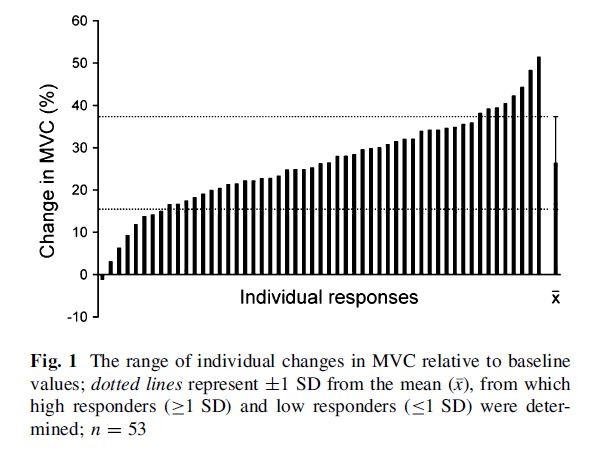
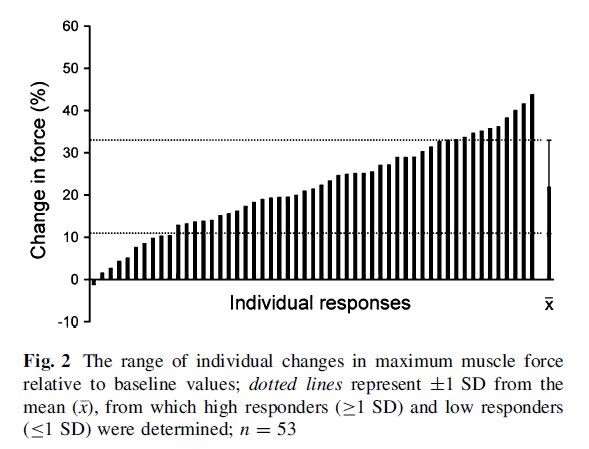
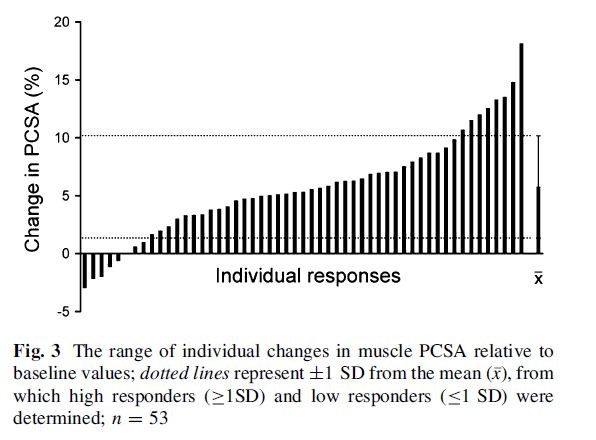
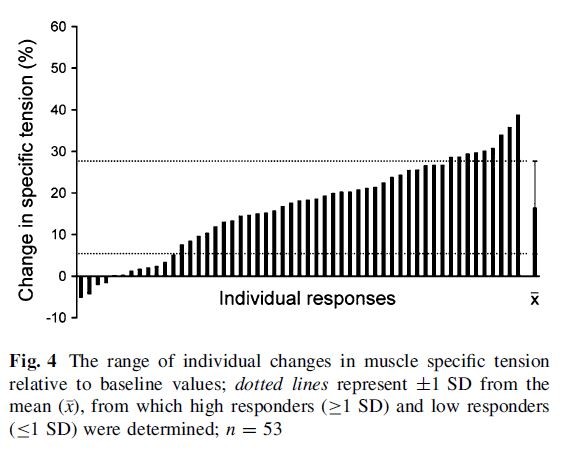
Figure 1-4: From Erskine et al 2010. MVC = maximum voluntary contraction, PCSA = physiological cross-sectional area.
Take the gain in maximal voluntary movement (MVC). A proportion of it will certainly be due to an increase in muscle force. However, an unknown amount is likely to result from increased inter-muscular coordination and acquisition of skill, both of which differ between people. How much, we don’t know (Erskine et al 2010).
Moreover, variation in strength and muscle gains are not necessarily correlated. Not only the variation is greater than the average, it does not correlate with age or sex, but it is possible to have high responders to strength and not to muscle gain, vice-versa, both high or both low (Ahtianen et al 2016).
In one recent study, the relation between muscle hypertrophy and strength was analyzed to test the hypothesis that there is no support for a causal relationship between the two. In other words, muscle gain does not cause strength gain although they are associated (Loenneke et al 2019).
From Loenneke et al 2019
In one study, changes in agonist neural drive, primary motor muscle volume, and pre-training strength combined explain about 60% of the variance in strength changes (Balshaw et al 2017).
Here is where we come closer to understanding the occurrence of “freaks or power”: increased rate of force development (RFD) during periodized maximum strength and power training is highly individual. That’s the title of the published study (Peltonen et al 2018). This is the only published research up to this day on RFD individual variation. Here is how it was designed and conducted: fourteen men (28 ± 6 years old) performed the same 10-week maximum strength and then a 10-week power training program. Maximal force and RFD were recorded during maximal isometric leg extension voluntary contractions repeatedly before every 7th training session (2 sessions/week). After the intervention, subjects were retrospectively divided into three groups based on their RFD improvements: (1) improved only during the maximum strength period (MS-responders, + 100 ± 35%), (2) improved only during the power period (P-responders, + 53 ± 27%) or (3) no improvement at all (non-responders, + 3 ± 9%).
From Peltonen et al 2018.
Periodized strength training-induced different inter-individual physiological responses and very different RFD increases in the experimental group. The authors emphasize that rapid force production is more sensitive to determine acute and chronic adaptations in the neuro-muscular system than maximal voluntary contraction force. For this reason, they suggest it could be a useful tool to customize training programs for individuals.
We still don’t know what the genetic determinants of strength manifestations are and how they interact to produce the phenomena we call “power output”, “rate of force development” or “maximal strength”. One candidate is chemokine (C-C motif) ligand 2 (CCL2), whose expression increases dramatically following muscle damage, and increases expression further with repeated bouts of exercise (Harmon et al 2010). Another interesting candidate is the protein tyrosine kinase-2 (PTK2) gene, which encodes focal adhesion kinase, a structural protein involved in lateral transmission of muscle fiber force (Erskine et al 2012).
To make things even more complicated, there is doubt concerning the methodology that produced the data about individual variable response to exercise. The question is not whether it is real – this is now widely accepted. The question is whether the “variants” are being properly measured. For example, Pickering and Kiely examined the existence of “non-responders” to exercise, a category often found in individual variability studies (Pickering & Kiely 2019). They concluded that non-responders don’t exist: they just represent a phenomenon that is not being captured by the methods employed in some studies. A similar concern was expressed by Dankel and Loenneke (2019), who offered a method to improve analytical accuracy in studies about differential responders to exercise.
Inter-individual variation is manifested in all types of exercise. A study comparing endurance (END) to sprint interval training (SIT), both of which involve VO2peak, lactate threshold, and submaximal exercise heart rate (HR) for performance, found that improvements within a given individual following END did not predict the improvement observed following SIT (and vice versa), individual patterns varied within individuals between END and SIT, and a global non-response to END and SIT in any specific individual was not observed (Bonafiglia et al 2016).
This is a graphic representation of inter-individual variation by measured variable:
Bonafiglia et al 2016
Such significant variation suggests both central and peripheral adaptations taking place and there is no way to predict an individual’s success in either activity given their performance in the other.
Another study examined the role of reactive oxygen and nitrogen species (RONS), or “redox phenotype”, in exercise adaptations under physiological in vivo conditions (Margaritelis et al 2018). The study showed that the group with the low exercise-induced oxidative stress exhibited the lowest improvements in a battery of classic adaptations to endurance training.
These recent findings shed light on possible causes for training prescription failures by coaches or as a result of following a program template. The idea that many academic and, worse, non-academic debates about the optimal number of sets, repetitions, exercises, and protocols were looking at the picture in the wrong way is not new. One example is the demonstration that the effort-to-benefit ratio is different for untrained, recreationally trained, and athlete populations (Peterson et al 2005).
The Practical Takeaway for the Coach and the Practitioner
Whether you are an independent coach or a practitioner, from the sports enthusiast to competitive athlete, it is unlikely that you have access to the research resources to monitor the variables studied in the publications cited in this article. Does that mean you can’t decide how to train or choose a training plan? Or does it mean you need a research team to program your training?
Neither: you have probably already intuitively self-selected according to some of these variables as a child or an adolescent. Humans feel pleasure in mastery (Lutkenhaus 1984, Jennings et al 1984, Jennings 2016). Part of the problem is solved.
If you have trained for some time, you probably also observed that you obtained nice results in some things, and none or negative results in others using one or more “cookie-cutter” program. There is something that doesn’t agree with your bench press with that frequency, that volume, that intensity or that placement in the micro-cycle split. Those who trained for a very long time, even without much reading, managed to fix things here and there and found an optimal plan that usually worked for them. Believe it or not, some elite athletes trained like that. Trial and error have always been a method used by humans to develop whatever they needed.
Today, with the abundance of information available on the Internet, with most classical literature of exercise science downloadable for free, at the end of the day, it is still trial and error that leads to optimal results in the long run. Of course, the abundance of information offers amazing shortcuts, especially in not getting injured.
User-friendly pieces on how to use Prilepin’s chart, on what assistance exercises can help improve a certain movement or how to organize your training in a plan are available. The work you have to put to design your plan and test it is not rocket science. There is a myriad of templates to use as a base. The time to select what works, that requires patience and systematic observation.
References
- Ahtiainen, Juha P., Simon Walker, Heikki Peltonen, Jarkko Holviala, Elina Sillanpää, Laura Karavirta, Janne Sallinen et al. "Heterogeneity in resistance training-induced muscle strength and mass responses in men and women of different ages." Age 38, no. 1 (2016): 10.
- Balshaw, Thomas G., Garry J. Massey, Thomas M. Maden-Wilkinson, Antonio J. Morales-Artacho, Alexandra McKeown, Clare L. Appleby, and Jonathan P. Folland. "Changes in agonist neural drive, hypertrophy and pre-training strength all contribute to the individual strength gains after resistance training." European journal of applied physiology 117, no. 4 (2017): 631-640.
- Bonafiglia, Jacob T., Mario P. Rotundo, Jonathan P. Whittall, Trisha D. Scribbans, Ryan B. Graham, and Brendon J. Gurd. "Inter-individual variability in the adaptive responses to endurance and sprint interval training: a randomized crossover study." PloS one 11, no. 12 (2016): e0167790.
- Dankel, Scott J., and Jeremy P. Loenneke. "A method to stop analyzing random error and start analyzing differential responders to exercise." Sports Medicine (2019): 1-8.
- Enoka, Roger M., and Jacques Duchateau. "Rate coding and the control of muscle force." Cold Spring Harbor perspectives in medicine 7, no. 10 (2017): a029702.
- Erskine, Robert M., Alun G. Williams, David A. Jones, Claire E. Stewart, and Hans Degens. "Do PTK2 gene polymorphisms contribute to the interindividual variability in muscle strength and the response to resistance training? A preliminary report." Journal of applied physiology 112, no. 8 (2012): 1329-1334.
- Erskine, Robert M., David A. Jones, Alun G. Williams, Claire E. Stewart, and Hans Degens. "Inter-individual variability in the adaptation of human muscle specific tension to progressive resistance training." European journal of applied physiology 110, no. 6 (2010): 1117-1125.
- Harmon, Brennan T., E. Funda Orkunoglu-Suer, Kasra Adham, Justin S. Larkin, Heather Gordish-Dressman, Priscilla M. Clarkson, Paul D. Thompson et al. "CCL2 and CCR2 variants are associated with skeletal muscle strength and change in strength with resistance training." Journal of applied physiology 109, no. 6 (2010): 1779-1785.
- Hernández-Davó, Jose Luis, and Rafael Sabido. "Rate of force development: reliability, improvements and influence on performance. A review." European Journal of Human Movement 33 (2014): 46-69.
- Hutton, Robert S. "Kinesthetic aftereffect, a measure of kinesthetic awareness." Perceptual and motor skills 23, no. 3_suppl (1966): 1165-1166.
- Jennings, Kay D., Leon J. Yarrow, and Patricia P. Martin. "Mastery motivation and cognitive development: A longitudinal study from infancy to 34 years of age." International Journal of Behavioral Development 7, no. 4 (1984): 441-461.
- Jennings, Kay Donahue. "Mastery motivation and the formation of self-concept from infancy through early childhood." In Mastery motivation in early childhood, pp. 36-54. Routledge, 2016.
- Jones, Eric J., Phil A. Bishop, Amanda K. Woods, and James M. Green. "Cross-sectional area and muscular strength." Sports Medicine 38, no. 12 (2008): 987-994.
- Loenneke, Jeremy P., Scott J. Dankel, Zachary W. Bell, Samuel L. Buckner, Kevin T. Mattocks, Matthew B. Jessee, and Takashi Abe. "Is muscle growth a mechanism for increasing strength?." Medical hypotheses 125 (2019): 51-56.
- Lutkenhaus, Paul. "Pleasure derived from mastery in three-year olds: Its function for persistence and the influence of maternal behavior." International Journal of Behavioral Development 7, no. 3 (1984): 343-358.
- Maffiuletti, Nicola A., Per Aagaard, Anthony J. Blazevich, Jonathan Folland, Neale Tillin, and Jacques Duchateau. "Rate of force development: physiological and methodological considerations." European journal of applied physiology 116, no. 6 (2016): 1091-1116.
- Margaritelis, Nikos V., Anastasios A. Theodorou, Vassilis Paschalis, Aristidis S. Veskoukis, Konstantina Dipla, A. Zafeiridis, George Panayiotou, Ioannis S. Vrabas, Antonios Kyparos, and Michalis G. Nikolaidis. "Adaptations to endurance training depend on exercise‐induced oxidative stress: exploiting redox interindividual variability." Acta Physiologica 222, no. 2 (2018): e12898.
- McGinnis, Peter Merton. Biomechanics of sport and exercise. Human Kinetics, 2013.
- Peterson, Mark D., Matthew R. Rhea, and Brent A. Alvar. "Applications of the dose-response for muscular strength development: a review of meta-analytic efficacy and reliability for designing training prescription." The Journal of Strength & Conditioning Research 19, no. 4 (2005): 950-958.
- Pickering, Craig, and John Kiely. "Do Non-Responders to Exercise Exist—and If So, What Should We Do About Them?." Sports Medicine 49, no. 1 (2019): 1-7.
- Proske, Uwe, and Simon C. Gandevia. "The kinaesthetic senses." The Journal of physiology 587, no. 17 (2009): 4139-4146.
- Proske, Uwe. "Kinesthesia: the role of muscle receptors." Muscle & Nerve: Official Journal of the American Association of Electrodiagnostic Medicine 34, no. 5 (2006): 545-558.
- Tuthill, John C., and Eiman Azim. "Proprioception." Current Biology 28, no. 5 (2018): R194-R203.
- Williamson, P. J., Atkinson, G., & Batterham, A. M. (2017). Inter-individual responses of maximal oxygen uptake to exercise training: a critical review. Sports Medicine, 47(8), 1501-1513.
- Zatsiorsky, Vladimir M., and William J. Kraemer. Science and practice of strength training. Human Kinetics, 2006.










